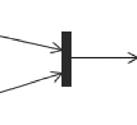Section 8.5. Pseudostates
8.5. PseudostatesPseudostates are special types of states that represent specific behavior during transitions between regular states. Combined with basic transitions, pseudostates can represent complex state changes within a state machine. Figure 8-17. A simplified SMTP protocol state machine Table 8-1 shows the types of pseudostates and their symbols. Refer to Figure 8-1 for an example showing how these symbols are used.
|
EAN: 2147483647
Pages: 132








